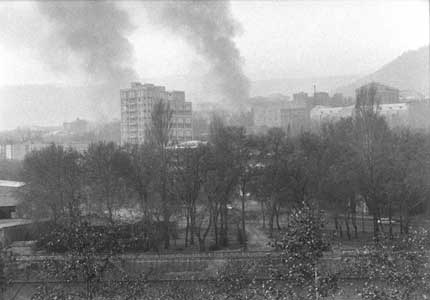 Born in Tbilisi in Georgia in 1956, Koka Ramishvili studied at the State Academy of Arts in Georgia then designed costumes for the group Georgy Balanchivadze. Since 1985 he has been a free-lance artist, and during the civil war in Georgia in 1991-92 he also worked as a documentary photographer. In Germany he exhibited for the first time in 1990 at the invitation of the artist Wolfgang Flatz, with whom he lived for awhile in Munich. Ramishvili is a member of the art-group 'Sector of Visual Investigation' and published the art-magazine 'Signal' from1997 to 1999. He is now living in Geneva and takes part in many networks between the eastern and western parts of Europe.
Born in Tbilisi in Georgia in 1956, Koka Ramishvili studied at the State Academy of Arts in Georgia then designed costumes for the group Georgy Balanchivadze. Since 1985 he has been a free-lance artist, and during the civil war in Georgia in 1991-92 he also worked as a documentary photographer. In Germany he exhibited for the first time in 1990 at the invitation of the artist Wolfgang Flatz, with whom he lived for awhile in Munich. Ramishvili is a member of the art-group 'Sector of Visual Investigation' and published the art-magazine 'Signal' from1997 to 1999. He is now living in Geneva and takes part in many networks between the eastern and western parts of Europe. More: Born in Tbilisi in Georgia in 1956 ...
Video: PARANOIA DRAWING LESSON
SYNOPSIS
At the origin of “The Drawing Lesson,” an image disappears. The process of drawing is here reversed: the image is deconstructed, erasing all physical traces until it remains only in our memories.
But later, through digital montage, used to rapidly increase the speed of the drawing process, the image acquires a new quality--that of a sign which cannot be read except in association with other signs. Drawing thus becomes writing, and the work itself becomes a sort of notebook, part of the biography of a man displaced, living in Geneva, Switzerland.
Koka Ramishvili, Geneva 2003
…The resulting dramatic effect is created by the psychological dimension that the process of drawing acquires on paper, an effect resembling that of narration and the qualities proper to it, such as repetition, tendentiousness, and a fixation with detail. The soundtrack, based on the scratching noise a soft lead pencil makes on paper, was especially composed for the work and gives the film a strong emotional charge.
Evguenia Kikodze, Moscow, 2003
Source: http://www.einzweidrei.info/expo/artistes/koramishb.htm
Bibliography:
Jorg Bader, Territory and Landscape. Cataloque, Geneva, CH, 2002Anne Tronche, Au verso de l'histoire, Catalogue, Paris, 1999
Anthea Nikolson & Keti Japaridze, ART magazine for University and College, U.K, 1998
Nana Kipiani, Transformation, Catalogue, Paris, 1997
Adrienne Braun, Die leuter haben klischees im kopf, Stuttgart Zeitung,1996.
Dr. Susan Reid, Head and Conduct, Catalogue. Arnolfini Gallery, Bristol, 1992.
Mary Sara, Breaking free from the old order, Yorkshire Post, Bristol, 1992.
Dr. Christa Hausler, Aus der topographie eines Geistesam schniipunkt der Welt, Catologue. Haus der Kulture der Welt, Berlin, 1991
Wolfgang FLATZ, Hinweise auf das dahinterlegende, Catalogue. Haus der Kulture der Welt, Berlin, 1991Anke Sterneborg, Leinwand &ndash locher als fenster, Der Tagesspiegel, Berlin, 1991
Christoph Herman, Radikale fragen nach dem kontext von Kunst, Kulturen, Berlin, 1991
Kim Levin, Western Eyes, Connosseus World, USA, 1990
Links:
* The art of camouflage (Kathrin Bettina Müller)
tipp: Global Photography Now
Post-Soviet States
Friday 29 September 2006, 14.00–17.00
In 1991 the USSR disintegrated and the Iron Curtain dropped to unveil progressive, multi-ethnic nations in Europe, Central Asia and the Caucasus region, which were striving for democracy and individual identity. Since then, new models of cultural identity have replaced the monuments and doctrine of the forefathers of the Soviet and Communist ideology: Vladimir Lenin and Joseph Stalin.
Leading international artists Zeigam Azizov, Anastasia Khoroshilova, Dmitry Gutov and Koka Ramishvili discuss photography in relation to the quest for cultural identity in the post-Soviet environment in a session chaired by Viktor Misiano, independent curator and editor of Moscow Art Magazine.
Source: http://www.tate.org.uk/modern/eventseducation/talksdiscussions/5794.htm











No comments:
Post a Comment